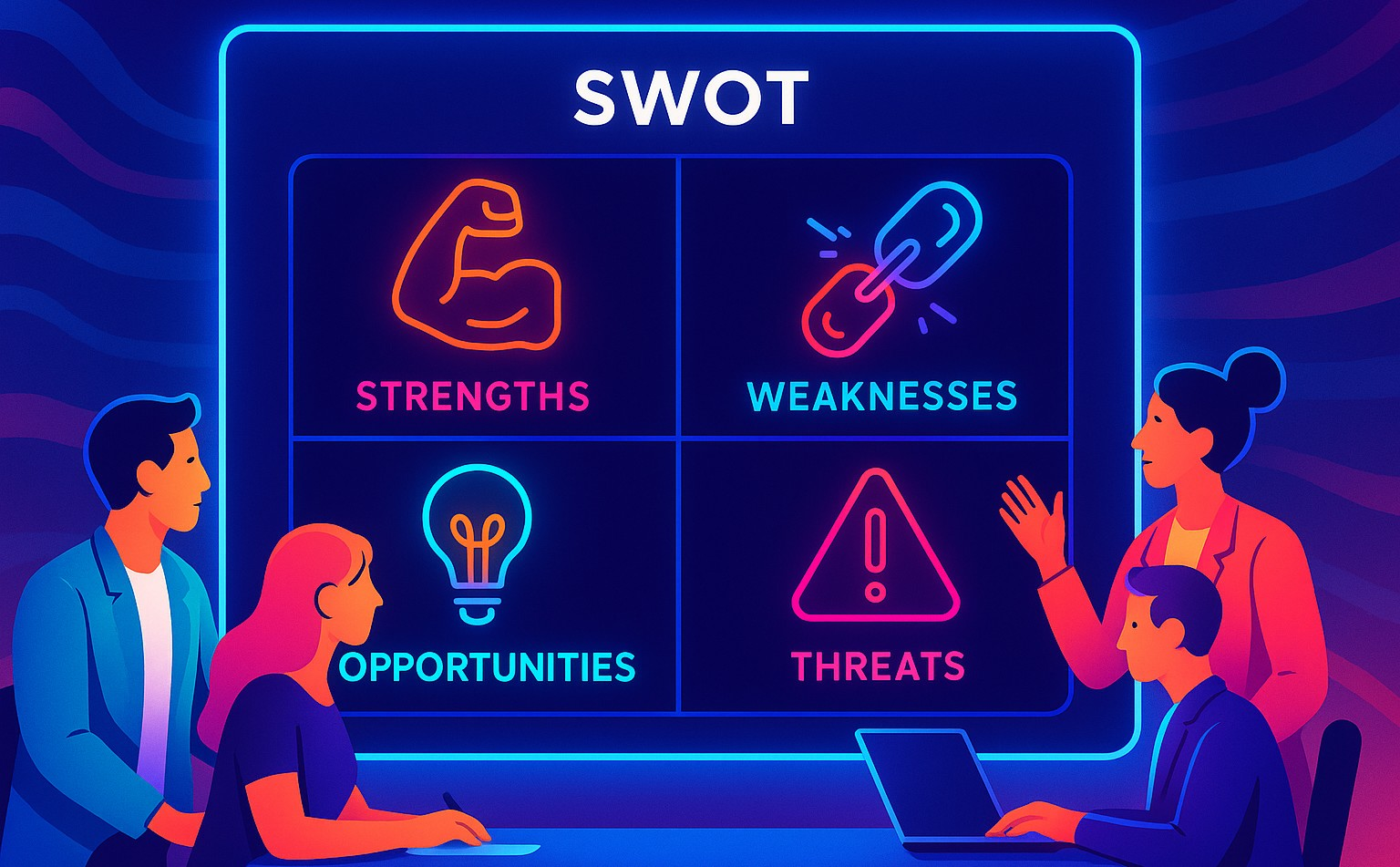The long-term success of any business depends largely on the quality of its planning. Today, entrepreneurs have access to various methods for analyzing and evaluating businesses and products. These include both new and time-tested methods. SWOT analysis is considered a classic in this field. This is what this article will cover. After reading it, you'll understand the meaning of SWOT and learn how to properly apply its key components in practice.
What Is a SWOT Analysis
SWOT analysis is a strategic planning method. It allows for a comprehensive analysis of a company, project, or product based on four criteria: strengths, weaknesses, opportunities, and threats. This methodology was developed by a group of American economists during the second half of the 20th century.
The origins of SWOT trace back to the 1960s at the Stanford Research Institute (SRI). There, Albert S. Humphrey and his team developed the SOFT framework (Satisfactory, Opportunity, Fault, Threat), which later evolved into the SWOT approach. Additionally, Harvard Business School professors Edmund P. Learned, C. Roland Christensen, Kenneth R. Andrews, and William D. Guth contributed to the development of strategic planning. They helped popularize concepts related to internal and external organizational factors.
By the 1970s and 1980s, SWOT concepts had spread throughout business education and practice. The modern form evolved gradually over time. Today, it remains popular among companies of all sizes and industries, largely due to its significant advantages.
Benefits of SWOT analysis include:
- This is a universal business analysis method. It is suitable for both large corporations and start-ups. It allows for a comprehensive assessment of the development prospects of virtually any offline or online business, as well as a specific project or competitor's business.
- The simplicity and accessibility of this tool make it suitable not only for professional economists but also for those without any specialized knowledge or skills. The results will be understandable to investors, partners, and other stakeholders without any prior explanation.
- Preparing a basic SWOT analysis doesn't require collecting and processing large amounts of information. A key set of data about the company, its products, competitors, market position, and so on is sufficient.
- The method provides a comprehensive analysis covering all key aspects and factors influencing a company's operations. It allows for a structured analysis of a company's strengths and weaknesses. This helps identify ways to neutralize threats with strengths and capitalize on opportunities to address weaknesses.

Now that you have a general understanding of this method, it is time to learn how to use SWOT analysis. As we mentioned earlier, the analysis is based on four key components: strengths, weaknesses, opportunities, and threats. Below, the four components will be discussed individually.
Strengths Leveraging Your Advantages
Here is a SWOT analysis example that you can complete yourself immediately. You need to fill out a short table divided into four sections: strengths, weaknesses, opportunities, and threats.
First, it's recommended to analyze the strengths that provide key advantages to your company or project. Before beginning, it is important to gather up-to-date information on internal and external factors that could influence the elements mentioned above.
When reviewing strengths, focus on aspects most relevant to your field of activity, such as sales, marketing, finance, new product launches, and so forth. To do this, gather a team of 5–7 people and brainstorm. Identify the key qualities of your company or project that differentiate you from competitors and give you an advantage.


To more accurately identify strengths using the SWOT method, the team leader should prepare a set of guiding questions. For example:
- What advantages differentiate your company or project?
- In what areas do you outperform your competitors the most?
- Why does a customer choose your product or service?
- What unique resources and skills do you possess that competitors lack?
- Which business processes yield the best results?
- What competencies and experience does your team have?
- What are the competitive advantages of your product?
- What unique selling proposition do you offer your customers?
- What values do you convey?
- What helps you strengthen your influence on your target audience?
Weaknesses Identifying Growth Areas
The second component of the SWOT framework is identifying the weaknesses of your company or project. To do this, conduct a detailed analysis of all the apparent and latent weaknesses. These are the factors that hinder the successful growth of your enterprise and the market promotion of its products. Identify existing constraints and other internal or external factors negatively impacting your business.
To achieve the most accurate and relevant results, the group should answer the following questions honestly:
- In which areas does your company lag behind its competitors?
- What factors prevent you from becoming a leader in your niche?
- Why are your employees not effectively performing their assigned tasks?
- What errors frequently occur in your business processes?
- What aspects do customers dislike about your products? Why are customers being lost?
- Where is the weakest point in your sales funnel?
- What resources or employee skills does the company lack?
- What areas need to be improved first?
Opportunities and Threats Navigating the Landscape

The third component of the SWOT analysis template is an assessment of opportunities. This focuses on external events and factors that can be leveraged to improve your company’s or product’s market position. This stage of the analysis should be accompanied by intensive brainstorming sessions, as some opportunities are difficult to spot immediately. For the best results, it's advisable to consider several aspects that could potentially impact your business. For example, technological developments and innovations, the current industry and economic climate, the state of competition, among others.
To conduct a detailed analysis of the possibilities, consider answering the following questions:
- Which industry trends are currently most in demand? Which are emerging?
- Is the demand for your company’s products increasing or decreasing?
- Which current industry or economic events could benefit the company or project?
- How does the current market situation affect your business, and how can it be leveraged for growth?
- What recent changes have occurred in the competitive landscape? Are new competitors entering or existing ones exiting the market?
- Have any new technologies emerged within the industry, and how can they be utilized to achieve organizational goals?
- Are there any market segments where your business is not currently active? Are these worth exploring?
The fourth component of the SWOT analysis is threats, which represent potential external risks as opposed to opportunities. This step requires analyzing external factors that could negatively impact the development of your company or project. It is important to note that these factors do not necessarily cause direct harm to your business, but they do have a potentially negative impact.
Consider that some events present both threats and opportunities. Furthermore, threats to some companies or projects may present significant development opportunities for their competitors.
The following questions will help you conduct a detailed threat analysis:
- What challenges does your company or its products face in the market?
- Is there a decline in demand for your company’s products or services?
- How does the political and economic situation in a country or region affect your business?
- Are there any competitors that could push you out of the market?
- Have alternative products emerged that could substitute your products or services?
- Are there any new laws or other official changes that could negatively impact your business?
After working through all four blocks of the SWOT analysis, you need to organize the collected data into a decision matrix. This will help you identify opportunities and consider the actions necessary for the successful development of your company or project.
As a result, you should have several strategic combinations or scenarios. For example, which strengths will allow you to maximize opportunities, or which weaknesses could lead to threats that could harm your business. After establishing the relationships between all the factors studied, your research team should develop a list of specific solutions, prioritize them, and systematically implement them.
Conclusion
Entrepreneurs and economists have utilized SWOT for business growth for over half a century, making it one of the most widely used strategic planning tools. It helps comprehensively analyze a company’s or project’s activities. The resulting data can then be used to formulate a development strategy—a plan of action to capitalize on opportunities and mitigate threats. One key advantage of SWOT analysis is its accessibility, even to non-specialists. It enables quick and accurate identification of a company’s or individual product’s strengths and weaknesses. This information can then be used effectively to enhance its market position.
